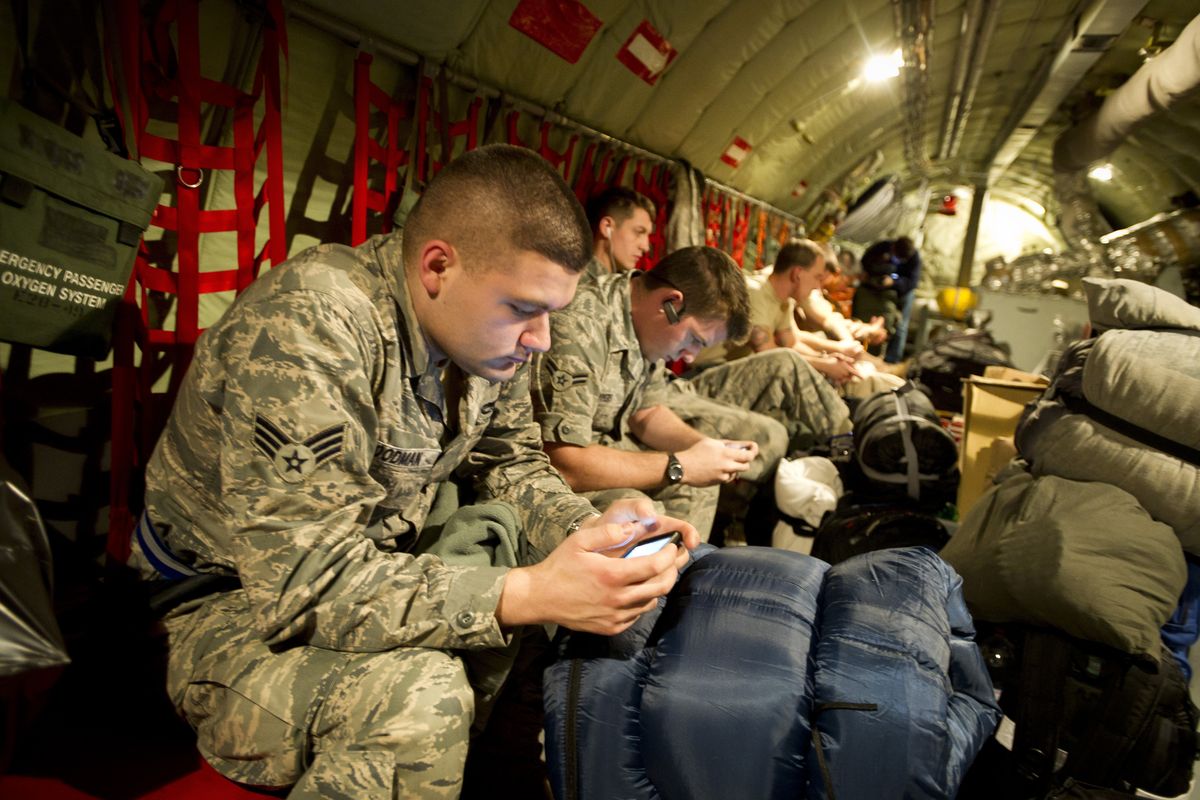For fuel, cargo and transport, troops rely on crews at Manas

MANAS TRANSIT CENTER, Kyrgyzstan – The slight evening drizzle had turned to a steady twilight rain, but Airman 1st Class Dustin Harder continued digging into the KC-135 aerial refueling tanker’s engines, using the jet’s broad wingspan to help stay dry.
The tanker had finished a refueling mission over Afghanistan and would be needed back in the air soon, ready to deliver more fuel to thirsty fighter jets providing air cover for U.S. and coalition ground forces or to cargo planes needing to extend their flight paths.
A Spokane native, Harder is part of the massive team of mechanics, machinists and other aircraft specialists known as “maintainers” who keep America’s aging KC-135 tanker fleet in the air.
“I like the work,” said Harder, a member of the Washington Air National Guard’s 141st Air Refueling Wing. “I’ve been volunteering all over and have been to Germany and other places, but this is my first time in Kyrgyzstan.”
With combat operations in Afghanistan intensifying, the demands on the roughly 1,000 military servicemen and -women deployed at Manas are immense.
Maintenance crews, cargo handlers and most others work 12-hour shifts, six days a week, keeping planes airworthy, getting troops and cargo loaded for deployment to Afghanistan, and bringing weary troops home.
“The numbers are staggering,” said Chief Master Sgt. Lee Becker, who’s serving a six-month deployment at Manas. “The amount of cargo moving out of here is amazing.”
The base, officially called a “transit center” to help appease Kyrgyz concerns about U.S. military presence in the former Soviet republic, has been a frequently overlooked piece of the overall Afghanistan story, though that has begun to change.
It opened in December 2001 to support combat operations in nearby Afghanistan and has become the expeditionary base to which airmen from Fairchild Air Force Base are most often deployed. Fairchild, in fact, operates weekly shuttle flights between Spokane and Manas, carrying cargo and either fresh crews on their way to new deployments or airmen on their way home in what it calls “iron swaps,” a reference to the practice of rotating KC-135s on and off the flight line.
Col. Dwight Sones, who was stationed at Fairchild for two years as a KC-135 pilot and now is in charge of the Manas base, considers the Spokane connection a distinct advantage.
“Fairchild is a known commodity,” Sones said. “I know their work ethic. I know they can get the job done.”
As the only major northern supply route into Afghanistan, the base operates around the clock.
About a third of all fuel delivered by air tankers over Afghanistan comes from Manas. On average, about 1,200 coalition combat troops move through the base daily, either on their way to the Afghan battlefields or on their way home. And, 6 million pounds of cargo move through the base each month, said Maj. John Elolf.
For the returning troops, Manas is a place to decompress for a couple of days before boarding charter jets for home.
“No one really spends a lot of time reminding everyone that it takes teamwork,” said Maj. Ben Retzinger, who oversees maintenance services at Manas. “Around here it’s quickly realized.”
Adding to the demands is the KC-135 itself.
The jet was designed during the 1950s using a modified Boeing 707 platform and has been slated for replacement for years. But a combination of bidding mishaps, political indecision and an embarrassing scandal involving Boeing and a top Air Force procurement official has continued to delay selection of the next-generation tanker, the backbone of the U.S. military’s envied ability to quickly put troops and equipment anywhere in the world.
In the meantime, guys like Retzinger and their crews continue working double time to keep the planes in the air.
When each tanker returns from a mission, it’s immediately inspected by its own flight crew and by four-member maintenance teams. Commanders want to know within 90 minutes what, other than fuel and a rested crew, the jets need before they’re ready to fly again. The goal is to get any additional work done within 2 1/2 hours.
“We’re looking at turnaround within four hours,” said Master Sgt. Jeff Nehring.
And when bigger problems emerge, the goal is to have the planes back on the flight line within 12 hours, the minimum amount of time pilots must be given between missions. Because of the age of the tankers – the last KC-135 was built in 1964 – machinists must be ready to create needed parts.
At stake is the success of combat missions over Afghanistan, where about a third of all aerial refueling is performed by tankers flying out of Kyrgyzstan.
It keeps maintainers like Harder, who uses his day off each week to sleep and do laundry, in heavy demand.
“It ain’t too bad,” he said, “as long as you keep busy.”